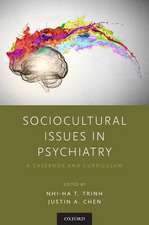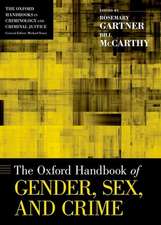The Cambridge Handbook of Personality Disorders: Cambridge Handbooks in Psychology
Editat de Carl W. Lejuez, Kim L. Gratzen Limba Engleză Paperback – 6 mai 2020
| Toate formatele și edițiile | Preț | Express |
|---|---|---|
| Paperback (1) | 476.87 lei 6-8 săpt. | |
| Cambridge University Press – 6 mai 2020 | 476.87 lei 6-8 săpt. | |
| Hardback (1) | 1538.86 lei 3-5 săpt. | |
| Cambridge University Press – 6 mai 2020 | 1538.86 lei 3-5 săpt. |
Din seria Cambridge Handbooks in Psychology
- 23%
 Preț: 1254.71 lei
Preț: 1254.71 lei - 11%
 Preț: 449.49 lei
Preț: 449.49 lei -
 Preț: 502.52 lei
Preț: 502.52 lei -
 Preț: 501.96 lei
Preț: 501.96 lei - 8%
 Preț: 426.60 lei
Preț: 426.60 lei -
 Preț: 486.56 lei
Preț: 486.56 lei - 5%
 Preț: 441.42 lei
Preț: 441.42 lei - 9%
 Preț: 1282.42 lei
Preț: 1282.42 lei -
 Preț: 494.25 lei
Preț: 494.25 lei - 8%
 Preț: 429.69 lei
Preț: 429.69 lei - 5%
 Preț: 397.85 lei
Preț: 397.85 lei - 23%
 Preț: 1246.12 lei
Preț: 1246.12 lei - 5%
 Preț: 439.60 lei
Preț: 439.60 lei - 19%
 Preț: 494.19 lei
Preț: 494.19 lei - 5%
 Preț: 718.47 lei
Preț: 718.47 lei -
 Preț: 511.59 lei
Preț: 511.59 lei - 8%
 Preț: 426.60 lei
Preț: 426.60 lei - 8%
 Preț: 427.05 lei
Preț: 427.05 lei - 8%
 Preț: 425.42 lei
Preț: 425.42 lei -
 Preț: 411.90 lei
Preț: 411.90 lei -
 Preț: 272.34 lei
Preț: 272.34 lei - 8%
 Preț: 425.42 lei
Preț: 425.42 lei - 9%
 Preț: 594.27 lei
Preț: 594.27 lei -
 Preț: 511.21 lei
Preț: 511.21 lei - 23%
 Preț: 1248.79 lei
Preț: 1248.79 lei -
 Preț: 370.88 lei
Preț: 370.88 lei - 8%
 Preț: 424.41 lei
Preț: 424.41 lei -
 Preț: 374.90 lei
Preț: 374.90 lei - 8%
 Preț: 427.49 lei
Preț: 427.49 lei -
 Preț: 511.59 lei
Preț: 511.59 lei - 5%
 Preț: 1538.86 lei
Preț: 1538.86 lei - 23%
 Preț: 2195.06 lei
Preț: 2195.06 lei - 8%
 Preț: 489.88 lei
Preț: 489.88 lei - 8%
 Preț: 428.36 lei
Preț: 428.36 lei -
 Preț: 488.47 lei
Preț: 488.47 lei - 9%
 Preț: 850.10 lei
Preț: 850.10 lei - 8%
 Preț: 430.05 lei
Preț: 430.05 lei -
 Preț: 497.35 lei
Preț: 497.35 lei -
 Preț: 283.03 lei
Preț: 283.03 lei
Preț: 476.87 lei
Preț vechi: 501.96 lei
-5% Nou
91.25€ • 95.53$ • 75.50£
Carte tipărită la comandă
Livrare economică 05-19 aprilie
Specificații
ISBN-10: 1108440096
Pagini: 552
Ilustrații: 17 b/w illus. 24 tables
Dimensiuni: 216 x 277 x 28 mm
Greutate: 1.36 kg
Editura: Cambridge University Press
Colecția Cambridge University Press
Seria Cambridge Handbooks in Psychology
Locul publicării:Cambridge, United Kingdom
Cuprins
List of Figures; List of Tables; List of Contributors; Introduction to the Cambridge Handbook of Personality Disorders Carl W. Lejuez and Kim L. Gratz; Part I. Etiology: 1. Neuroimaging in Personality Disorders Chi C. Chan, Daniel H. Vaccaro, Nina L .J. Rose, Laura E. Kessler and Erin A. Hazlett; 2. Issues and New Directions in Personality Disorder Genetics Kerry L. Jang and Fiona Choi; 3. Environmental and Sociocultural Influences on Personality Disorders Brianna J. Turner, Julie Prud'homme and Nicole Legg; 4. Personality Pathology in Youth Carla Sharp and Barbara De Clercq; Part II. Models: 5. Controversies in the Classification and Diagnosis of Personality Disorders Joel Paris; 6. Categorical Models of Personality Disorders Igor Weinberg; 7. The Five-Factor Model of Personality Disorders Joshua D. Miller and Thomas A. Widiger; 8. Interpersonal Models of Personality Pathology Michael J. Roche and Emily B. Ansell; Part III. Individual Disorders and Clusters: 9. Cluster a Personality Disorders John G. Kerns; 10. Borderline Personality Disorder Alexander L. Chapman, Nora H. Hope and Brianna J. Turner; 11. An Integrative Biobehavioral Trait Perspective on Antisocial Personality Disorder and Psychopathy Sarah J. Brislin and Christopher J. Patrick; 12. Narcissistic and Histrionic Personality Disorders Aaron L. Pincus, Sindes Dawood, Leila Z. Wu and Chloe F. Bliton; 13. Cluster C Anxious-Fearful Personality Pathology and Avoidance Charles A. Sanislow and Anna Darre Hector; Part IV. Assessment: 14. Methods and Current Issues in Dimensional Assessments of Personality Pathology Chloe M. Evans, Trevor F. Williams and Leonard J. Simms; 15. Categorical Assessment of Personality Disorders: Considerations of Reliability and Validity Janine D. Flory; 16. Assessment of Mechanisms in Personality Disorders Sheila E. Crowell, Parisa R. Kaliush and Robert D. Vlisides-Henry; Part V. Treatment: 17. Cognitive Behavioral Approaches M. Zachary Rosenthal, Kristin P. Wyatt and Kibby McMahon; 18. Psychoanalytic/Psychodynamic Approaches to Personality Disorders Peter Fonagy, Anthony Bateman, Patrick Luyten, Elizabeth Allison and Chloe Campbell; 19. Using DSM-5 and ICD-11 Personality Traits in Clinical Treatment Bo Bach and Jennifer Presnall-Shvorin; 20. Brief Therapeutic Approaches for Personality Disorders Katherine L. Dixon-Gordon, Lindsey C. Conkey and Sherry E. Woods; 21. Recent Developments in the Pharmacologic Management of Personality Disorders Paul S. Links, Philippe Boursiquot and Madison Links; Index.
Recenzii
'This handbook is a comprehensive examination of the facts and issues in the diagnosis, treatment, and neurobiology of personality disorders. It brings together many of the core theorists, clinicians, and researchers in the field, making it a must-read for any serious student of this topic and an excellent reference for researchers at any level.' Mary C. Zanarini, Harvard University and Director of the Laboratory for the Study of Adult Development, McLean Hospital
'… a must-have for practitioners in the mental health field … this handbook provides in-depth analysis of the etiology and treatment of challenging disorders … is a well-documented look at personality disorders that anticipates potential or ongoing controversies about their etiology, diagnosis, or treatment.' R. E. Osborne, Choice
Descriere
This handbook provides both breadth and depth regarding current approaches to the understanding, assessment, and treatment of personality disorders. The five parts of the book address etiology; models; individual disorders and clusters; assessment; and treatment. A comprehensive picture of personality pathology is supplied that acknowledges the contributions and missteps of the past, identifies the crucial questions of the present, and sets a course for the future. It also follows the changes the Diagnostic and Statistical Manual of Mental Disorders (DSM–5) has triggered in the field of personality disorders. The editors take a unique approach where all chapters include two commentaries by experts in the field, as well as an author rejoinder. This approach engages multiple perspectives and an exchange of ideas. It is the ideal resource for researchers and treatment providers at all career stages.










